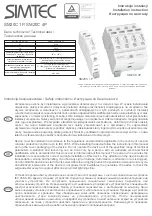
E.
Wind Power
Wind power systems are an attractive option as a way to
power a remote air monitoring system.
If you want to operate the system when there is not enough
wind you need to add a battery system. Use previous
guidance from the section on battery systems and solar
panels to determine the required size of the battery system.
Wind power systems are readily available in capacities
from a few hundred watts to several thousand watts.
Power from a wind system varies with the square of the
rotor diameter and the cube of the wind speed. The wind
speed typically is higher at 50 feet and higher above the
ground surface than it is at 20 feet above the ground surface.
Example: You have a wind machine with a 12 foot diameter
rotor and your wind speed is 20 mph.
Watts
= 12 squared times 20 cubed divided by 500
= 144 times 8,000 divided by 500
= 2,300 watts
If this wind system generated this much power for 8 hours per
day you could operate the air sampling system in the previous
example continuously with the appropriate battery system.
Refer to the National Renewable Energy Laboratory
website at WWW.NREL.GOV for a map depicting wind power
availability in the US.
141
E.
Wind Power
Wind power systems are an attractive option as a way to
power a remote air monitoring system.
If you want to operate the system when there is not enough
wind you need to add a battery system. Use previous
guidance from the section on battery systems and solar
panels to determine the required size of the battery system.
Wind power systems are readily available in capacities
from a few hundred watts to several thousand watts.
Power from a wind system varies with the square of the
rotor diameter and the cube of the wind speed. The wind
speed typically is higher at 50 feet and higher above the
ground surface than it is at 20 feet above the ground surface.
Example: You have a wind machine with a 12 foot diameter
rotor and your wind speed is 20 mph.
Watts
= 12 squared times 20 cubed divided by 500
= 144 times 8,000 divided by 500
= 2,300 watts
If this wind system generated this much power for 8 hours per
day you could operate the air sampling system in the previous
example continuously with the appropriate battery system.
Refer to the National Renewable Energy Laboratory
website at WWW.NREL.GOV for a map depicting wind power
availability in the US.
141
E.
Wind Power
Wind power systems are an attractive option as a way to
power a remote air monitoring system.
If you want to operate the system when there is not enough
wind you need to add a battery system. Use previous
guidance from the section on battery systems and solar
panels to determine the required size of the battery system.
Wind power systems are readily available in capacities
from a few hundred watts to several thousand watts.
Power from a wind system varies with the square of the
rotor diameter and the cube of the wind speed. The wind
speed typically is higher at 50 feet and higher above the
ground surface than it is at 20 feet above the ground surface.
Example: You have a wind machine with a 12 foot diameter
rotor and your wind speed is 20 mph.
Watts
= 12 squared times 20 cubed divided by 500
= 144 times 8,000 divided by 500
= 2,300 watts
If this wind system generated this much power for 8 hours per
day you could operate the air sampling system in the previous
example continuously with the appropriate battery system.
Refer to the National Renewable Energy Laboratory
website at WWW.NREL.GOV for a map depicting wind power
availability in the US.
141
E.
Wind Power
Wind power systems are an attractive option as a way to
power a remote air monitoring system.
If you want to operate the system when there is not enough
wind you need to add a battery system. Use previous
guidance from the section on battery systems and solar
panels to determine the required size of the battery system.
Wind power systems are readily available in capacities
from a few hundred watts to several thousand watts.
Power from a wind system varies with the square of the
rotor diameter and the cube of the wind speed. The wind
speed typically is higher at 50 feet and higher above the
ground surface than it is at 20 feet above the ground surface.
Example: You have a wind machine with a 12 foot diameter
rotor and your wind speed is 20 mph.
Watts
= 12 squared times 20 cubed divided by 500
= 144 times 8,000 divided by 500
= 2,300 watts
If this wind system generated this much power for 8 hours per
day you could operate the air sampling system in the previous
example continuously with the appropriate battery system.
Refer to the National Renewable Energy Laboratory
website at WWW.NREL.GOV for a map depicting wind power
availability in the US.
141
















































